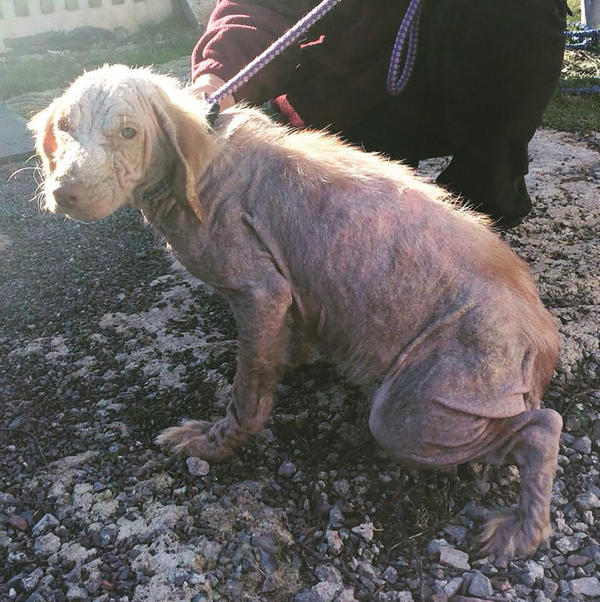
Mange in dogs
- Mange is a skin disease caused by mites and two types can affect dogs, sarcoptic and demodectic
- Sarcoptic mange (or canine scabies) is the most common of the two and is highly contagious
- It causes intense itching and, as a result of scratching, dogs suffer open sores, scabs and hair loss
- Owners can catch sarcoptic mange from infected dogs but the mites cannot complete their life cycle on humans so infections are short lived
- Demodectic mange is fairly rare and only passed between a mother and her puppies. Some breeds of dog have a tendency to develop this condition.
Sarcoptic mange
What is sarcoptic mange?
Sarcoptic mange is caused by tiny, microscopic spider-like mites which burrow beneath the skin surface, laying eggs. Eggs hatch into larvae in three to 10 days and move about on the skin as they develop into adult mites and go onto reproduce. Adult mites live for three to four weeks.
How can dogs catch sarcoptic mange?
The condition is highly contagious between dogs, through direct contact and shared bedding. Dogs can also catch sarcoptic mange from infected urban foxes but these cases are relatively rare.
What are the symptoms of sarcoptic mange in dogs?
The mites prefer hairless skin, so the first areas normally affected on a dog will be the insides of the ears, armpits and belly. Your dog will be itchy and the skin will become red and inflamed. But as with many skin problems, the appearance is very variable. As the dog scratches and bites fiercely at the skin it becomes more and more irritated, hair loss might develop. Scabs often form and the skin becomes crusty. Secondary infections from open sores are possible. If left untreated, lymph nodes can also swell.
How is sarcoptic mange in dogs diagnosed?
Sarcoptic mange is tricky to diagnose. Although in theory mites should be visible on a skin scraping examined under the microscope, in practice this can be difficult. Other tests, such as blood tests, are even less reliable. Many cases are treated on the basis of symptoms and there is a case for treating every dog with an itch that fails to respond to other treatments. Treatment can also rule out scabies, an allergy or other skin complaints.
What is the treatment for sarcoptic mange in dogs?
Sarcoptic mange is relatively easy to treat with medication. It is important to treat regularly as directed by your vet, completing the full course, and to discuss whether other pets in the household need treatment too. Steroids, in cream or tablet form, may also be used to reduce the inflammation on the skin. Antibiotics may also be prescribed to treat secondary infections caused by the open sores. Your vet will be able to advise you on what treatment is best for your dog. With treatment, dogs will normally be clear of the disease within a month.
Can humans catch mange from dogs?
Yes, but sarcoptic mange mites can only complete their life cycles on dogs and some other animals. This means that while human infections can still cause lots of irritation, they will be short-lived. If your dog is suspected to have sarcoptic mange, you should keep them off of furniture that you share, wash their bedding and avoid very close contact, particularly with children.
Can other dogs catch mange from mine?
Yes, and you should avoid close contact with other dogs outside the home until the infection has cleared. All other dogs in the home should be treated for sarcoptic mange if one dog has it, even if they don’t show symptoms.
Demodectic mange
What is demodectic mange?
Demodectic mange, also known as red mange, is a rarer type of the disease. Most dogs have the mites in small numbers and it is passed on by a mother to her puppies. In most cases, disease doesn’t develop and healthy immune systems will keep it dormant. In rare cases, when immunity is compromised, the parasites may take hold and the disease could develop. The condition is not thought to be contagious to other animals and humans.
What are the symptoms of demodectic mange in dogs?
Demodectic mange can take three forms in dogs:
Localised:
- Scaly bald patches can form on the dog’s face. It’s common among puppies. Consult your vet who will decide if treatment is necessary.
Generalised:
This is when more parts of a dog’s body are affected by the patchy, infected skin. Secondary infections can make the condition very itchy and your dog may smell. In most cases, generalised demodectic mange affects dogs under the age of 18 months that have an immune defect. In up to half of these cases, the immune system recovers and is able to supress the parasites. When generalised demodectic mange occurs in older dogs, it is an indication of a potential underlying problem affecting immunity.
Demodectic Pododermatitis:
This is when the condition just affects the paws but it can be hard to treat and diagnose. Bacterial infections usually develop with this condition and the infection can often run deep through the tissue. Old English sheepdogs and shar peis tend to be more prone to this.
How is demodectic mange treated?
It will depend on what type of the condition your dog has and your vet will be able to advise you on what’s best. Your dog might be prescribed medication, topical creams and/or medicated baths.
Can demodectic mange be prevented?
Keeping your dog in optimum health will reduce the likelihood of them developing demodectic mange as it will give their immune system the best chance of suppressing the parasites responsible. Stress can affect immunity, as can hormonal changes, so neutering will help. Also keep your dog’s worming and flea treatments up to date.
Can demodectic mange be cured?
When dogs develop demodectic mange at a young age, under 18 months, there is a very good chance that their immune system will recover and the disease will be cured altogether. Older dogs that develop the condition are harder to treat. But while a cure is not always possible, most cases can be managed with ongoing treatment.








